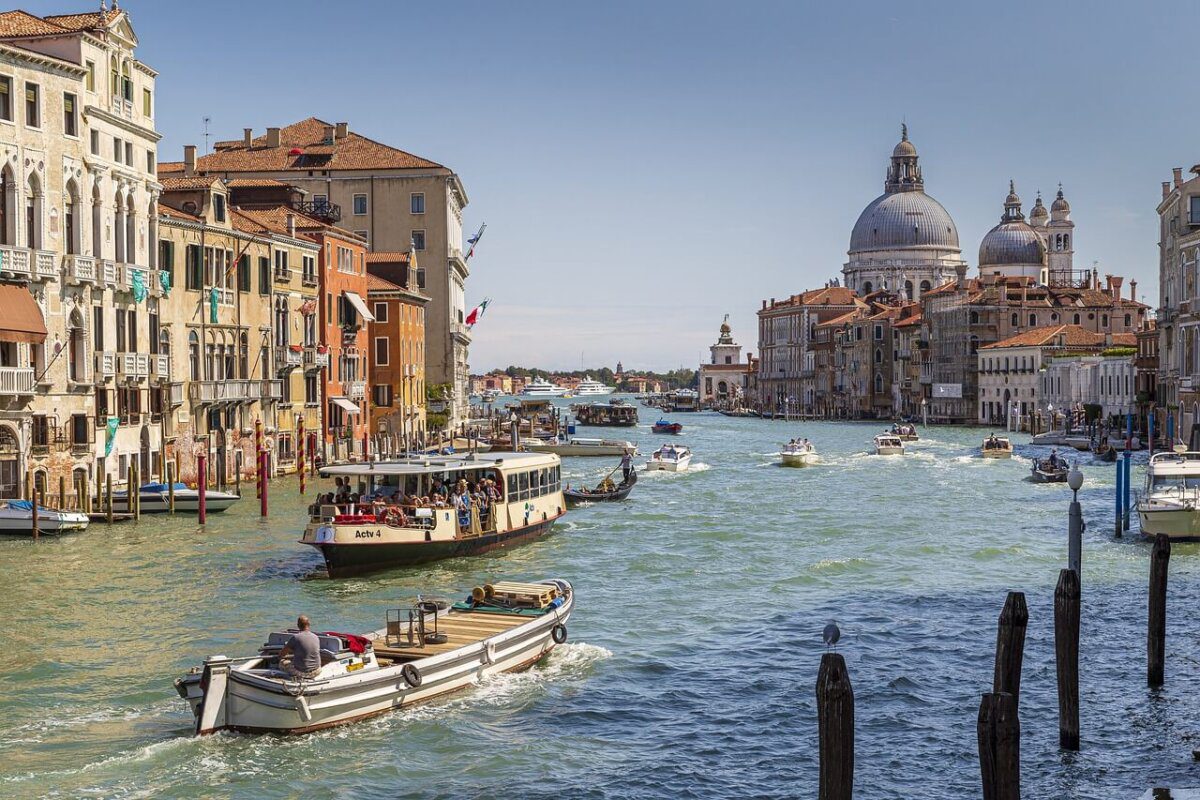Welcome to Venice, a city where enchantment is woven into its very fabric.
This mesmerizing maze of canals, each more picturesque than the last, captures the heart of all who wander its waterways.
The city’s rich tapestry of art and history unfolds around every corner, echoed in the grandeur of its bridges and the elegant decay of its architecture.
Venice is a living museum, a place where the past dances in harmony with the present, especially during the vibrant carnivals that bring its streets to life.
Its famed bridges are not just structures but gateways to stories untold, spanning across the serene waterways.
The enigmatic Venetian masks, a symbol of the city’s love for art and intrigue, add to the allure of this unique destination.
Here, history, romance, and art blend, creating a symphony of experiences that resonate deep within the soul.
Let me invite you to explore ten enchanting places in Venice that will etch themselves in your memory, painting a picture of a city that’s as surreal as it is real, as timeless as it is fleeting.

My list of top places to see in Venice
Here’s my list of ten unforgettable places in Venice (in alphabetical order).
Arsenale di Venezia
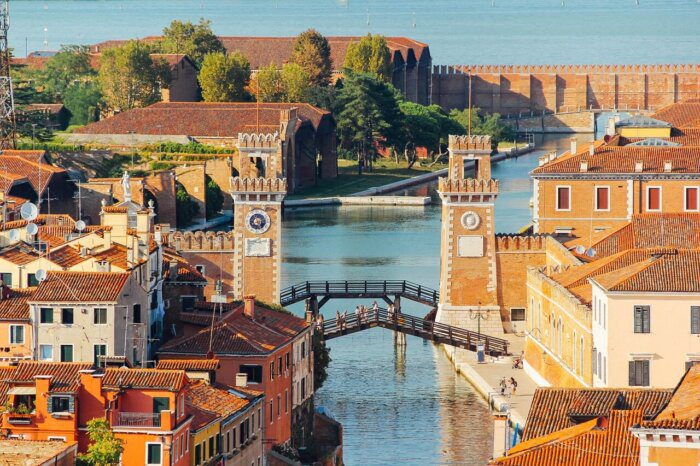
Did you know…?
The Arsenale di Venezia, once the heart of Venice’s naval power, was one of the earliest large-scale industrial enterprises in history.
This historic shipyard, established in the 12th century, was a marvel of its time. It could produce a ship per day, thanks to its groundbreaking assembly line production.
This innovation was centuries ahead of its time, predating similar methods in the industrial revolution.
The Arsenale’s efficiency and scale were so remarkable that it became a symbol of the Venetian Republic’s might and wealth.
Today, it stands as a testament to Venice’s innovative spirit, a lesser-known gem that offers a unique window into the city’s illustrious past.
Discovering the Arsenale di Venezia is like uncovering a hidden chapter in the story of human ingenuity, one that continues to inspire and amaze visitors.
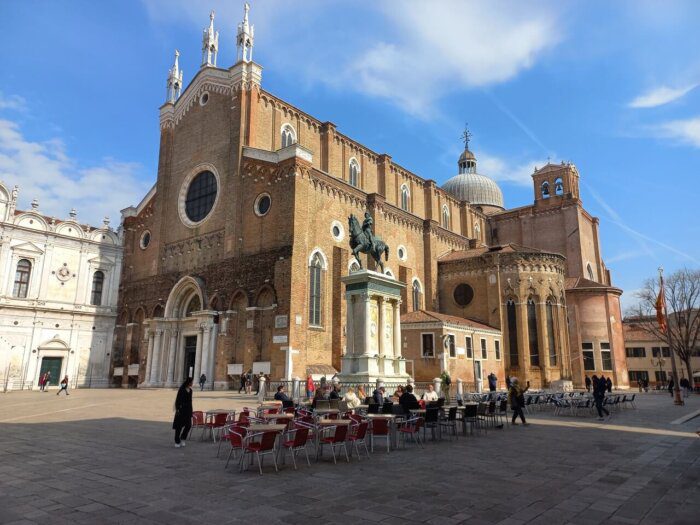
What is the Arsenale di Venezia and why see it?
The Arsenale di Venezia stands as a monumental testimony to Venice’s era as a dominant maritime power.
Founded in the 12th century, this sprawling shipyard was the backbone of the Venetian naval fleet and a key to the city’s historical dominance in Mediterranean trade.
Here, Venetian shipbuilding prowess came to life, with craftsmen employing advanced techniques to create vessels that bolstered Venice’s naval and commercial strength.
The impressive architecture of the Arsenale, including the majestic Porta Magna, reflects Venice’s fusion of military might and artistic flair.
Inside, ancient dry docks and expansive warehouses narrate the story of a city that once controlled seas with its maritime ingenuity.
As a centerpiece of Venice’s naval history, the Arsenale offers visitors not just a glimpse into shipbuilding heritage, but also into the broader narrative of Venice’s rise and reign as a powerful state, shaping European and Mediterranean history.
Its historical and architectural significance makes it a compelling destination for those seeking to understand Venice’s past glory.
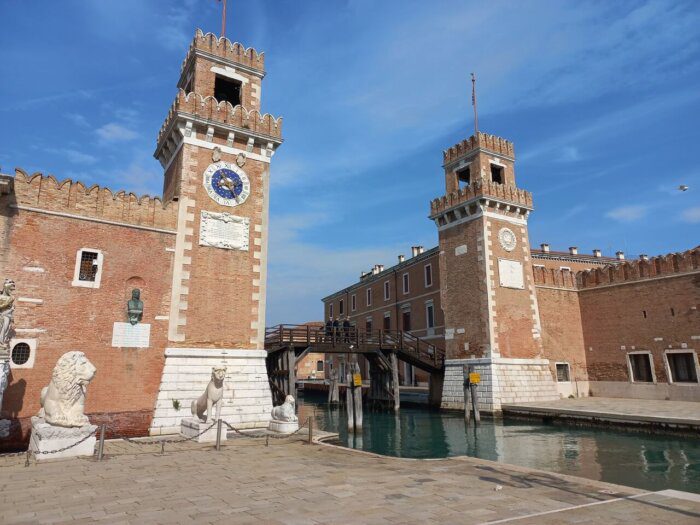
How to enjoy the Arsenale di Venezia?
The Arsenale di Venezia is located in the Castello district, a serene area east of Venice’s historic center.
To reach it, take the Vaporetto water bus, Line 1 or 4.1, and alight at the Arsenale stop. Walking is also an option, a scenic 20-minute stroll from St. Mark’s Square.
Visitors should note that while parts of the Arsenale are open to the public, other sections are restricted, as it still serves as a naval base.
Exploring the Arsenale offers a quieter, more authentic Venetian experience, away from the bustling tourist centers.
To fully appreciate its history and architecture, consider a guided tour, which can provide deeper insights into its past and present roles in Venice’s maritime saga.
Cannaregio
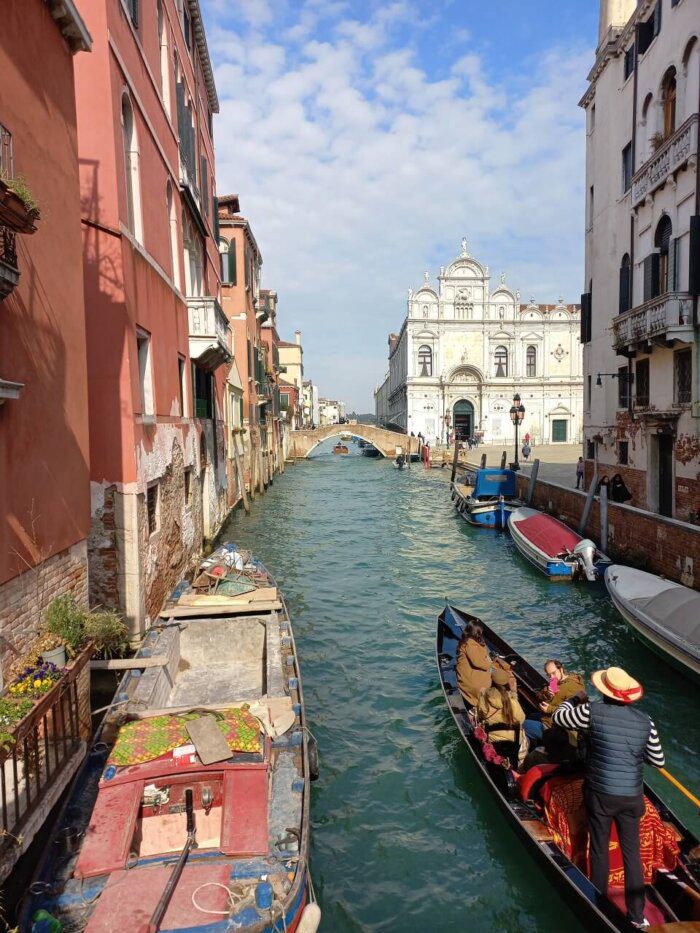
Did you know…?
Cannaregio, a tranquil district in Venice, harbors a hidden historical gem: the world’s first Jewish Ghetto.
Established in 1516, it’s a poignant slice of history. This area became a refuge for Jews fleeing persecution in Europe.
Remarkably, the term ‘ghetto’ originated here. It was derived from the local foundry, or “geto” in Venetian dialect.
Today, Cannaregio’s Ghetto is a serene, culturally rich quarter. Its narrow streets and tall, densely packed buildings reflect its unique past.
Visitors can explore historic synagogues and a Jewish museum, offering a rare glimpse into this community’s enduring legacy.
This lesser-known facet of Cannaregio adds a profound depth to the Venetian experience, revealing layers of history often overlooked by typical tourist paths.

What is Cannaregio and why see it?
Cannaregio, one of Venice’s six districts, is a captivating blend of history and local life.
It stretches from the train station to the Rialto Bridge. Known for its picturesque canals and less-touristed streets, it offers a glimpse into authentic Venetian life.
Cannaregio boasts striking architecture, like the Madonna dell’Orto church with works by Tintoretto.
The area’s tranquil canals are lined with charming eateries and artisan shops.
Cannaregio’s mix of historical significance and everyday Venetian culture makes it a must-visit for those seeking a quieter, more authentic experience.
How to enjoy Cannaregio?
Cannaregio is located in northern Venice, easily reachable on foot or by water.
From St. Mark’s Square, a leisurely 25-minute walk will get you there. Alternatively, take the Vaporetto water bus, with multiple lines servicing the area. The train station, Santa Lucia, is also situated in Cannaregio, making it accessible for those arriving by train.
For a full experience, explore Cannaregio on foot. This district’s charm lies in its narrow alleys and canal-side pathways.
Cannaregio is quieter than Venice’s central areas, offering a peaceful exploration.
Be respectful of the local community, especially in the Jewish Ghetto. Photography is welcomed but be mindful in religious or private spaces.
Early mornings or late afternoons are ideal for avoiding crowds. Local eateries and shops in Cannaregio offer authentic Venetian crafts and cuisine, enhancing the experience.
The Doge’s Palace (Palazzo Ducale)
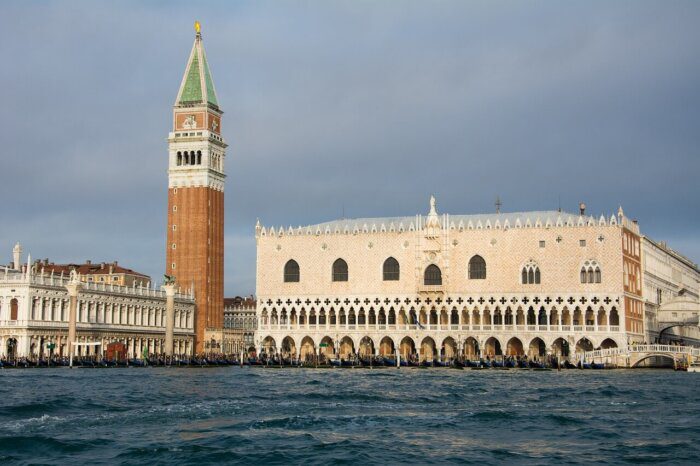
Did you know…?
One lesser-known fact about Doge’s Palace in Venice is its secret network of hidden passages and chambers.
These clandestine routes, including the notorious “Pozzi” (prison cells) and the “Piombi” (attic prisons), weave through the palace, revealing its darker, mysterious side.
Among these, the most famous is the “Bocca di Leone,” a mouth-shaped letterbox for anonymous denunciations. Citizens would slip accusations against others, often leading to trials and imprisonments.
This secretive system played a crucial role in maintaining the Doge’s power and the Venetian Republic’s order.
Today, these hidden aspects of the palace can be explored through guided “Secret Itineraries” tours, offering a unique perspective of Venice’s history, far removed from its usual romantic imagery.
This intriguing feature of Doge’s Palace adds an element of intrigue and surprise for visitors, deepening the understanding of Venice’s complex past.
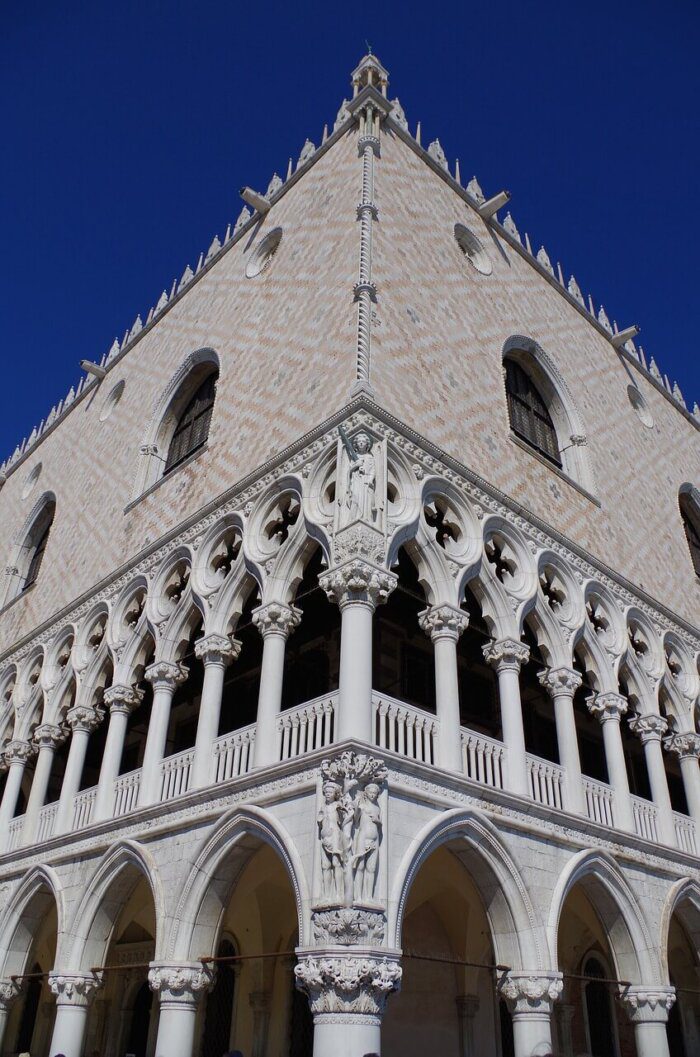
What is the Doge’s Palace and why see it?
Doge’s Palace in Venice, a masterpiece of Gothic architecture, stands majestically by St. Mark’s Square.
Once the residence of the Doge, it symbolized the power and wealth of the Venetian Republic.
Its façade, adorned with intricate stonework and arched windows, overlooks the lagoon, creating a stunning visual.
Inside, the palace is a treasure trove of art, including works by Tintoretto and Veronese.
The grandiose Scala d’Oro (Golden Staircase) and opulent chambers reflect Venice’s former glory.
The palace also houses the dark and eerie prison cells, famously connected by the Bridge of Sighs. This contrast between lavish splendor and somber imprisonment adds to the palace’s intrigue.
Doge’s Palace is not just a historic building; it’s a symbol of Venice’s rich and complex history, making it a must-visit for anyone interested in the city’s past and artistic heritage.
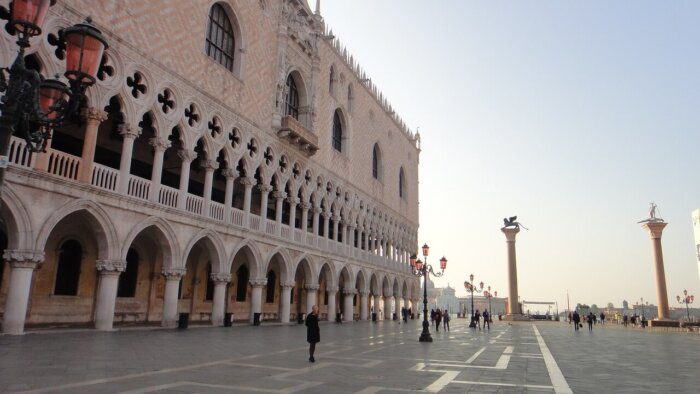
How to enjoy the Doge’s Palace?
Doge’s Palace is prominently located in St. Mark’s Square, the heart of Venice.
Easily accessible, it’s a short walk from the San Marco Vaporetto (water bus) stops.
Visitors should pre-book tickets to avoid long queues, especially during peak tourist seasons.
The palace offers various tours, including the standard and ‘Secret Itineraries’ tour, each offering a unique glimpse into Venetian history. To fully appreciate its history, consider an audio guide or a guided tour.
The palace can be crowded, so visiting early in the morning or late afternoon is advisable for a more relaxed experience. Remember to check opening hours and any temporary closures before visiting.
Dorsoduro
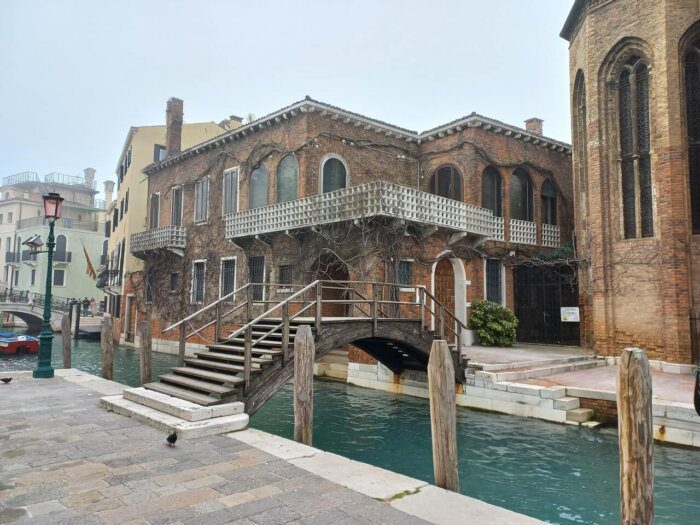
Did you know…?
Dorsoduro, one of Venice’s six sestieri, harbors a unique, lesser-known gem: the world’s only gondola workshop, Squero di San Trovaso.
Dating back to the 17th century, this quaint, rustic boatyard contrasts with Venice’s grand architecture.
Here, skilled artisans craft and repair gondolas, preserving a centuries-old tradition.
Unlike other Venetian buildings, the squero’s design resembles mountain huts, reflecting the origins of its craftsmen from the Cadore region.
This workshop is not typically open to the public, but visitors can view it from across the canal.
Watching gondolas being handcrafted offers a rare glimpse into Venice’s living heritage.
The sight of this traditional boatyard amidst Dorsoduro’s artistic and architectural splendors adds a unique, authentic touch to the Venetian experience, bridging past and present.
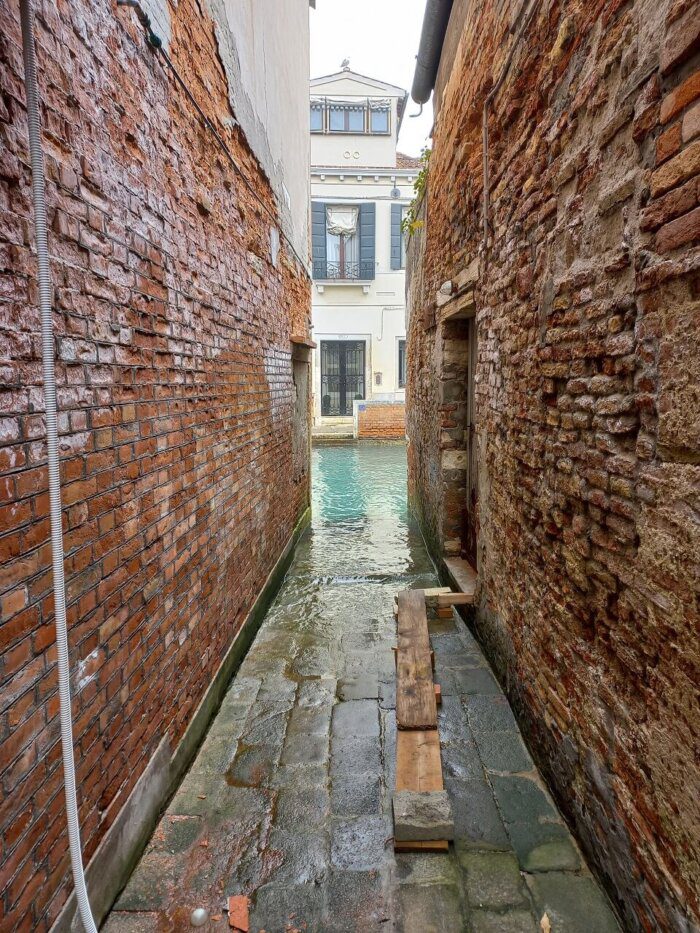
What is Dorsoduro and why see it?
Dorsoduro, a serene and artistic district in Venice, is known for its picturesque canals and cultural richness.
It’s home to the prestigious Ca’ Foscari University, infusing the area with youthful energy.
The district boasts several renowned museums, including the Peggy Guggenheim Collection and the Accademia Gallery, housing masterpieces of Venetian art. Dorsoduro’s charm lies in its blend of grand palazzos and quaint, colorful houses along peaceful waterways.
The area offers an authentic Venetian experience, with fewer tourists and more locals. Highlights include the Church of San Sebastiano, with works by Veronese, and the lively Campo Santa Margherita, a popular spot for dining and nightlife.
The Zattere promenade provides stunning views of the Giudecca Canal, perfect for leisurely strolls.
Dorsoduro’s unique blend of art, academia, and authentic Venetian life makes it a captivating area for visitors seeking a quieter, yet culturally rich, exploration of Venice.
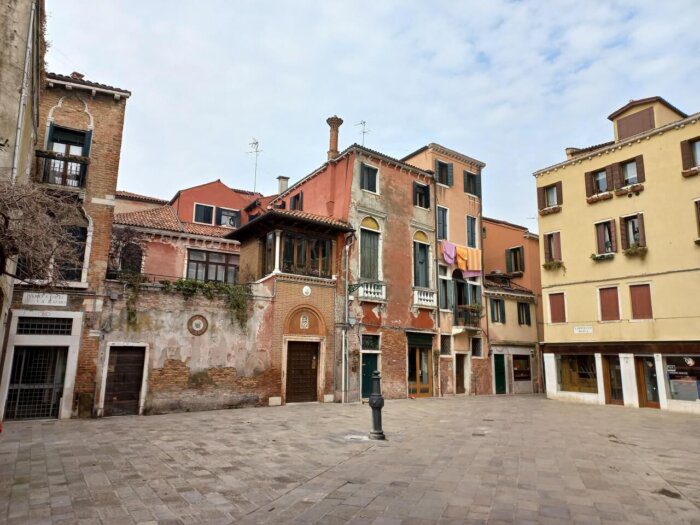
How to enjoy Dorsoduro?
Dorsoduro is located in the southern part of Venice, easily accessible by Vaporetto water buses, with stops like Accademia and Zattere along its borders.
For a scenic approach, take Line 1 along the Grand Canal and disembark at Accademia.
Alternatively, a pleasant walk from St. Mark’s Square takes around 20 minutes.
Dorsoduro is perfect for exploring on foot, with its less crowded streets and hidden corners offering a more relaxed atmosphere.
The area is known for its art galleries and museums, so allocating enough time to appreciate these cultural highlights is essential.
Dining in local trattorias offers a taste of authentic Venetian cuisine. Visitors should be mindful of the residential nature of this district, respecting the tranquility that makes Dorsoduro so special.
For photography enthusiasts, the district offers picturesque canals and architecture, but always ask for permission before photographing private property or residents.
Grand Canal (Canal Grande)
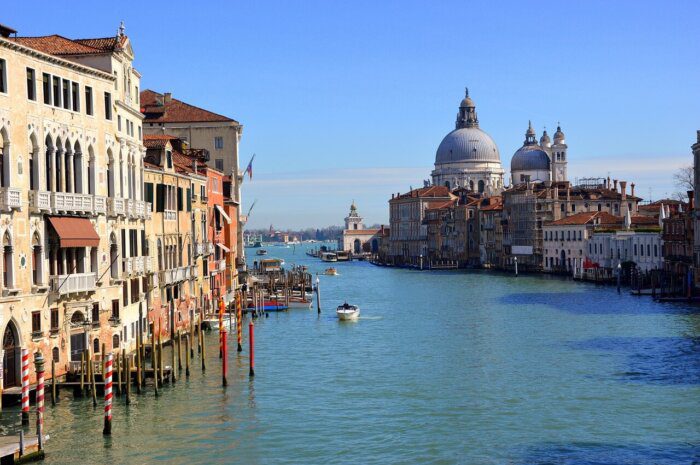
Did you know…?
An interesting fact about Venice’s Grand Canal is that it follows the path of an ancient river.
Centuries ago, this river flowed through the lagoon before Venice was built.
Over time, as the Venetians constructed the city, they shaped the river into the Grand Canal.
This historical transformation created the city’s main transportation artery.
The canal’s serpentine route, resembling a reverse ‘S’, is a remnant of its natural origins.
This intriguing blend of natural geography and human ingenuity highlights Venice’s unique relationship with water.
Learning about the Grand Canal’s evolution offers a deeper appreciation of Venice’s extraordinary urban landscape.
This fascinating aspect adds an extra layer of wonder to the already enchanting experience of exploring the Grand Canal.
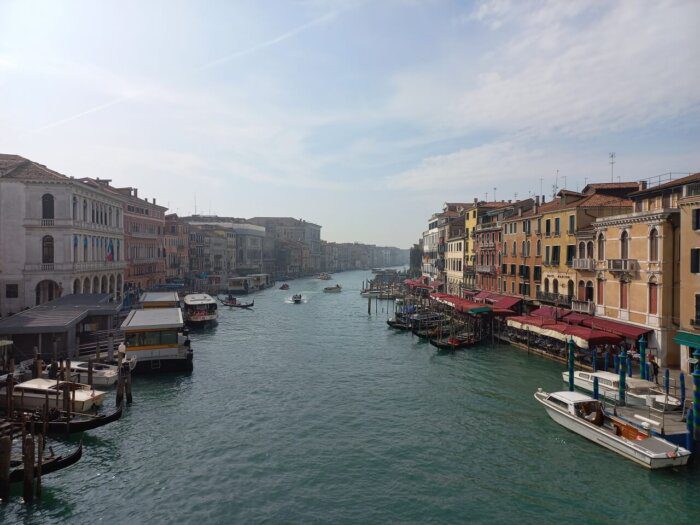
What is Grand Canal and why see it?
The Grand Canal, Venice’s main waterway, is a spectacular 3.8-kilometer-long channel winding through the heart of the city.
It’s flanked by opulent palazzos and historic buildings, reflecting centuries of Venetian wealth and power.
This canal serves as the main corridor for public transport, with Vaporettos (water buses) and gondolas gliding along its waters.
The Rialto Bridge, one of only four bridges crossing the Grand Canal, offers iconic views and is a marvel of Renaissance engineering.
Each building along the canal tells a story, showcasing architectural styles from Byzantine to Baroque.
The Grand Canal isn’t just Venice’s most important waterway; it’s a floating showcase of the city’s history and culture.
A journey along its waters provides an unparalleled perspective of Venice, making it an absolute must-visit for any traveler to the city.
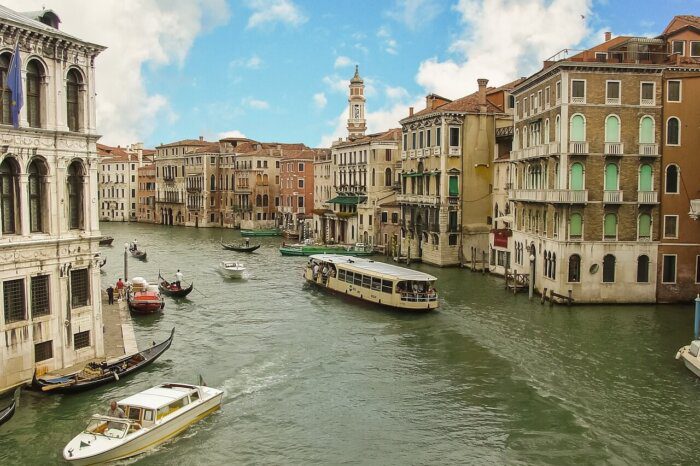
How to enjoy Grand Canal?
The Grand Canal snakes through the heart of Venice, easily accessible from any part of the city.
The best way to experience it is by Vaporetto, Venice’s water bus, with several lines running along the canal. Key stops include San Marco, Rialto, and Accademia.
For a more intimate experience, hire a gondola or a water taxi. Visitors should be aware that gondola rides can be pricey, so it’s wise to agree on the fare beforehand.
When traveling by Vaporetto, purchasing a day pass can be more economical than single tickets.
Keep cameras ready for stunning views, but also be mindful of personal belongings, as these areas can attract pickpockets.
Experiencing the Grand Canal is not just about sightseeing; it’s about immersing oneself in the lifeblood of Venice, where every view and every moment is a piece of Venetian history.
Punta della Dogana
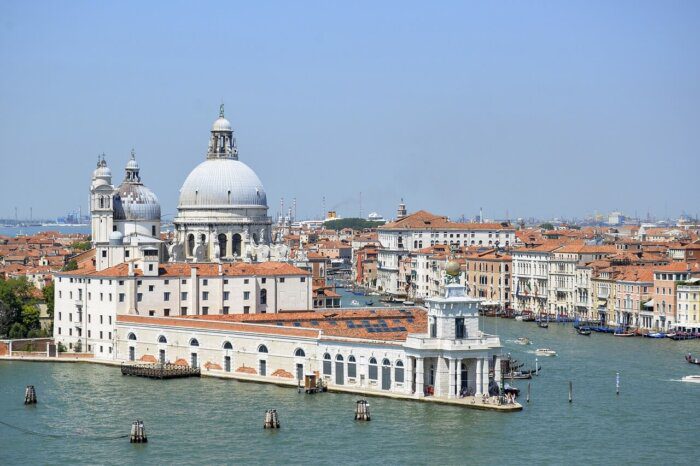
Did you know…?
Punta della Dogana, now a renowned center for contemporary art, has a fascinating historical quirk that often goes unnoticed.
This triangular piece of land, marking the separation between the Grand Canal and the Giudecca Canal, was crucial for Venice’s maritime activities.
Historically, the building served as a customs checkpoint, overseeing the goods entering the city.
What many don’t know is that its strategic location made it a silent witness to Venice’s maritime history, seeing centuries of trade and cultural exchange.
This building, with its rich past, was masterfully restored by the famed architect Tadao Ando, who preserved its historical essence while infusing modern aesthetics.
His work subtly incorporated elements reflecting the building’s past, creating a dialogue between the old and the new.
This blend of history and contemporary art makes Punta della Dogana not just a gallery, but a testimony to Venice’s ever-evolving narrative, offering visitors a unique window into the city’s soul.
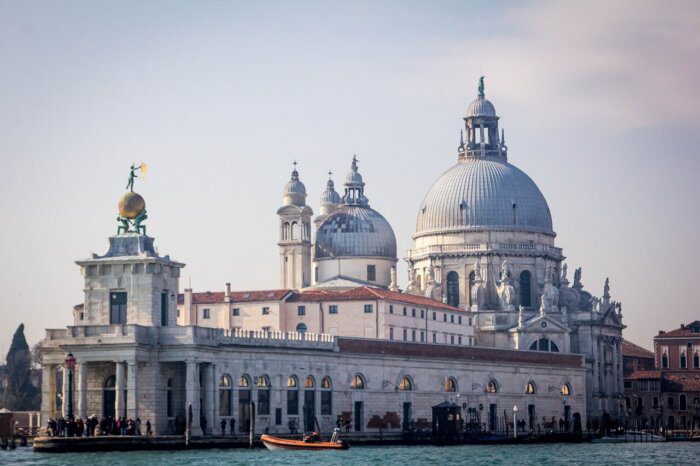
What is Punta della Dogana and why see it?
Punta della Dogana, a former customs house at the tip of Dorsoduro, now serves as a contemporary art museum. It is a minimalist art space, blending historical architecture with modern design.
It’s part of the François Pinault Foundation, showcasing rotating exhibitions of contemporary art from around the world.
The building itself is a masterpiece, with its preserved original features juxtaposed against sleek, modern elements.
Its unique location at the city’s edge provides a tranquil escape from the bustling center, allowing for uninterrupted contemplation of art and architecture.
Punta della Dogana is special for its artistic significance and its role in Venice’s maritime history, making it a compelling visit for art enthusiasts and history buffs alike.
Its fusion of the old and the new encapsulates the spirit of Venice, a city where history and modernity coexist harmoniously.
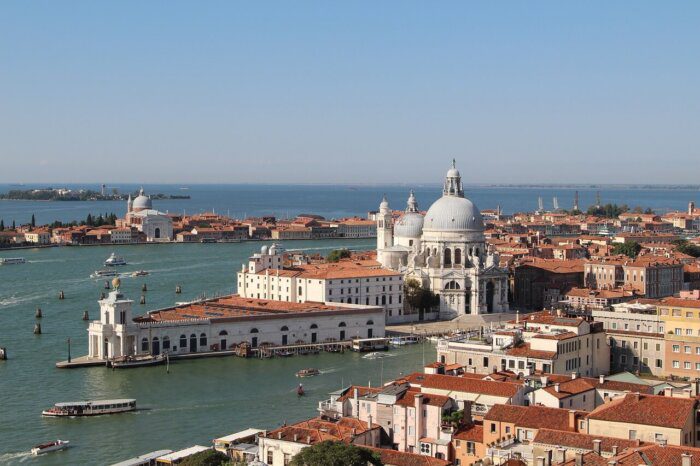
How to enjoy Punta della Dogana?
Punta della Dogana is located at the tip of the Dorsoduro district, overlooking the Grand Canal and the Giudecca Canal.
To get there, take the Vaporetto water bus to the Salute stop, which is a short walk away from the museum.
The proximity to Santa Maria della Salute Church makes it a convenient dual visit.
Tourists should be aware that the museum specializes in contemporary art, offering a different experience from the classic Venetian art found elsewhere in the city.
Visitors should allocate enough time to fully appreciate the art and the unique architecture of the building.
Advance ticket booking is advisable, especially during peak tourist seasons, to avoid long waits.
The museum’s location provides stunning views of Venice, making it a perfect spot for memorable photos.
Rialto Bridge (Ponte di Rialto)
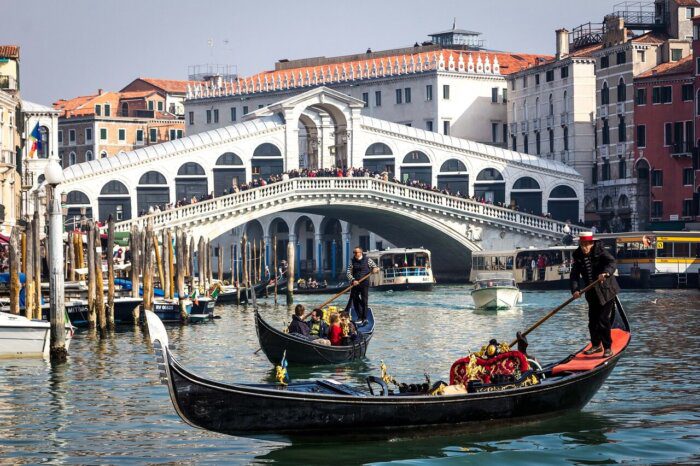
Did you know…?
A lesser-known fact about the iconic Rialto Bridge in Venice is its role as the birthplace of the city’s first bank.
In the 16th century, the area around the bridge became a bustling commercial hub, leading to the establishment of the world’s first official pawnshop, the “Banco Rosso.”
This innovative financial institution was a response to the growing economic activity in the area. It offered secured loans, a revolutionary concept at the time, and laid the foundations for modern banking systems.
The presence of Banco Rosso and other financial institutions around Rialto marked a significant shift in Venice’s economic history, turning the area into a financial center.
Today, as visitors cross this architectural marvel, they’re treading on ground that was once at the forefront of financial innovation.
This historical tidbit adds a layer of economic significance to the Rialto Bridge, enriching the experience of those who walk its span with a sense of connection to the past.
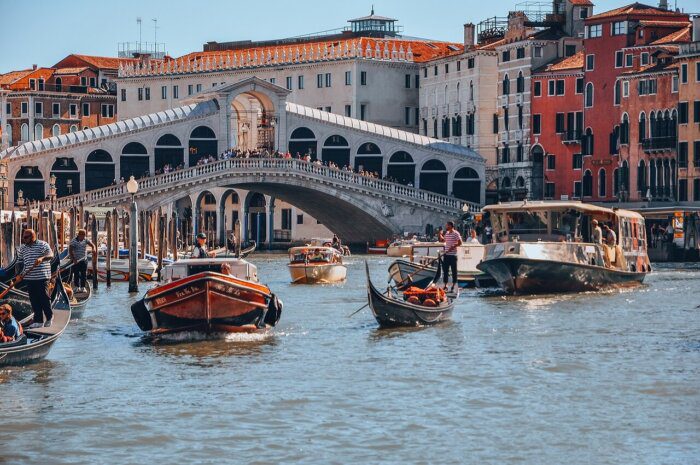
What is Rialto Bridge and why see it?
The Rialto Bridge, spanning the Grand Canal in Venice, is an architectural icon and a symbol of the city’s historical and economic significance.
Built in the late 16th century, it is the oldest bridge crossing the Grand Canal and one of only four.
Designed by Antonio da Ponte, the bridge’s distinctive stone arch design was considered revolutionary at the time.
The Rialto Bridge is not just a means of crossing the canal; it’s a bustling marketplace, hosting a variety of shops and stalls in its porticoes.
The bridge’s central position made it the heart of commercial Venice for centuries.
Today, it offers stunning views of the Grand Canal, making it a popular spot for tourists and photographers.
Its blend of historical importance, architectural beauty, and vibrant market life makes the Rialto Bridge a must-visit landmark in Venice, embodying the city’s spirit and its rich past.
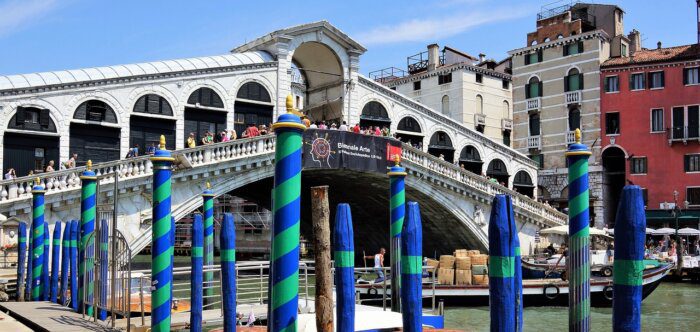
How to enjoy Rialto Bridge?
The Rialto Bridge is centrally located on the Grand Canal in Venice, easily accessible by foot or Vaporetto. The closest Vaporetto stops are “Rialto” and “Rialto Mercato” on lines 1 and 2.
For those exploring Venice on foot, the bridge is a short walk from St. Mark’s Square and connects the San Marco and San Polo districts.
Tourists should be aware that the bridge is often crowded, especially during peak tourist hours.
While the shops on the bridge offer a variety of souvenirs, be mindful of prices, as they can be higher due to the tourist-centric location.
The views from the bridge are spectacular, so don’t forget to bring a camera. However, be cautious of pickpockets in crowded areas and keep personal belongings secure.
Enjoying the Rialto Bridge is about embracing the bustling atmosphere and taking in the panoramic views of the Grand Canal, a quintessential Venetian experience.
San Polo
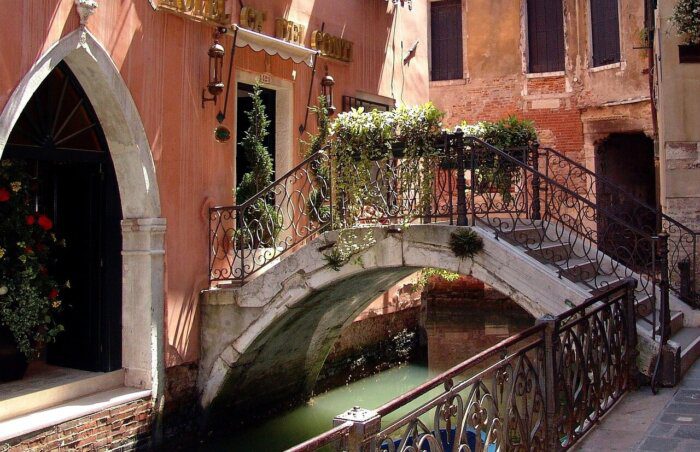
Did you know…?
San Polo, known for its vibrant Rialto Market and historic sites, also boasts a unique, lesser-known feature: the narrowest street in Venice.
Calle Varisco, just 53 centimeters wide at its narrowest point, is tucked away in this bustling district.
This hidden alleyway offers a tangible sense of Venice’s medieval urban layout, where space was at a premium and streets were often mere passageways.
Discovering Calle Varisco is like finding a secret thread in the city’s intricate tapestry, a reminder of how Venice’s unique architecture adapted to its lagoon environment.
For visitors wandering through San Polo, seeking out this narrow street provides a quirky and memorable addition to their Venetian adventure, adding an element of surprise and discovery to the exploration of this historic district.
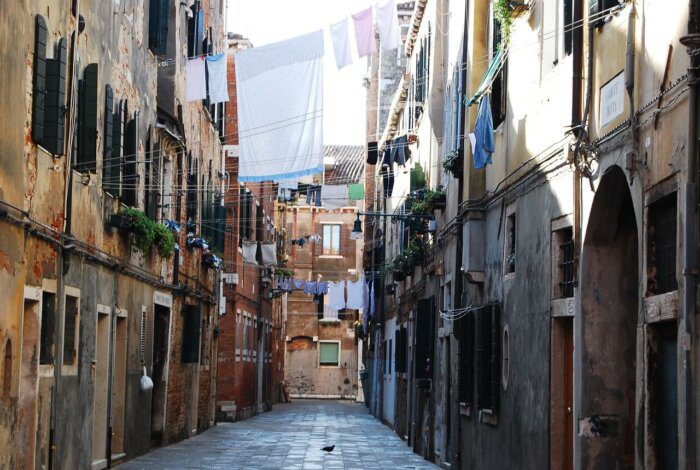
What is San Polo and why see it?
San Polo, the smallest of Venice’s six sestieri, is renowned for its rich history and vibrant atmosphere.
This district, named after the Church of San Polo, is home to the famous Rialto Bridge and Market, bustling centers of commerce and local life.
San Polo’s narrow, winding streets and charming squares, like the lively Campo San Polo, are quintessentially Venetian.
The area boasts a plethora of historic sites, including the majestic Basilica di Santa Maria Gloriosa dei Frari, housing masterpieces by Titian.
San Polo is also known for its intimate osterias and trattorias, offering authentic Venetian cuisine.
The district’s blend of historical significance, architectural beauty, and culinary delights makes it a compelling destination.
Visitors to San Polo can immerse themselves in the essence of Venice, experiencing the city’s traditional charm and lively character.
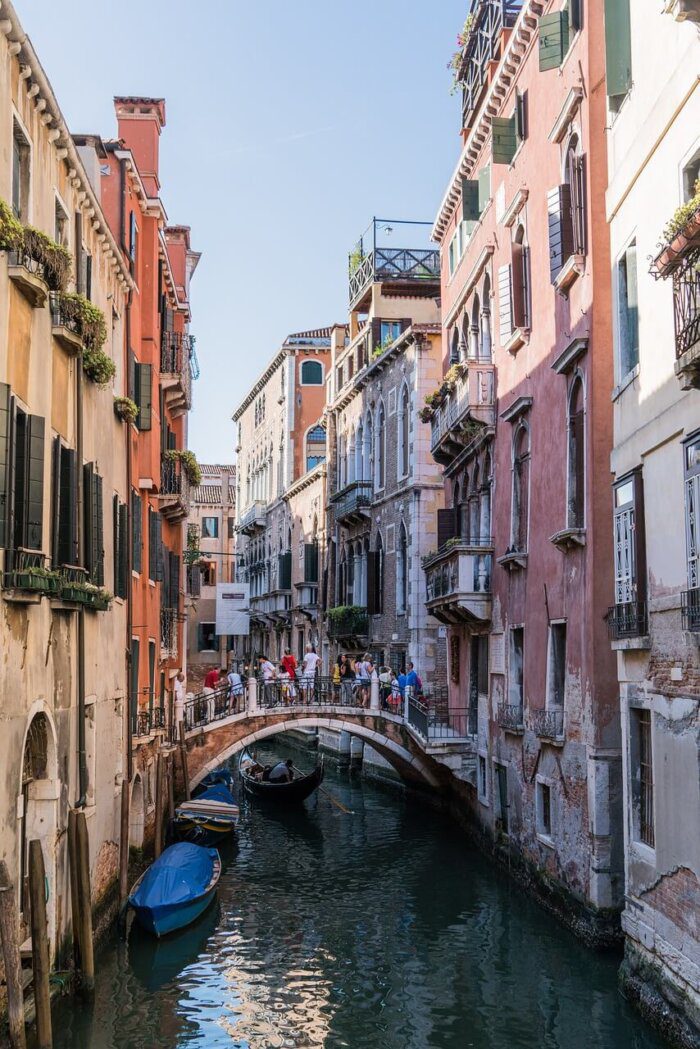
How to enjoy San Polo?
San Polo, nestled in the heart of Venice, is easily accessible on foot or by Vaporetto. The nearest Vaporetto stops are “San Tomà” and “Rialto,” serving lines 1 and 2.
For those exploring by foot, it’s a short walk from St. Mark’s Square, crossing the Rialto Bridge.
Tourists should be prepared for narrow, often crowded streets.
San Polo is famous for its historic sites and vibrant local markets, so allow ample time for exploration.
Be mindful of high water, or “acqua alta,” which can occasionally flood the streets, especially in late autumn and winter. Keeping an eye on local tide forecasts can be helpful.
While navigating, be respectful of residential areas and maintain a low noise level.
The district offers a variety of dining options; trying local specialties in smaller, less touristy eateries can enhance the experience.
San Polo’s blend of historic charm and bustling local life provides an authentic Venetian experience, making it a must-visit for any traveler to the city.
St. Mark’s Square (Piazza San Marco)
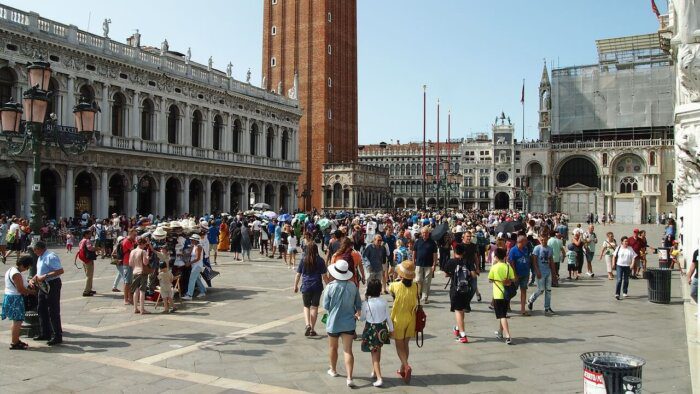
Did you know…?
St. Mark’s Square, a grand symbol of Venetian splendor, has an intriguing architectural secret: it’s subtly inclined.
The square was deliberately designed with a gentle slope towards the Basilica of St. Mark.
This gradient is not immediately noticeable to the eye, but it plays a crucial role in the square’s drainage system.
During “acqua alta”, the high tides that occasionally flood Venice, this slope helps to channel water towards strategically placed drains, preventing prolonged flooding.
The design showcases the ingenuity of Venetian architects in adapting their construction techniques to the city’s unique aquatic environment.
This subtle yet ingenious feature of St. Mark’s Square is a testimony to Venice’s historical battle against the rising tides and an example of how the city has ingeniously merged functionality with aesthetic beauty.
Discovering this hidden aspect of St. Mark’s Square’s design adds an extra layer of appreciation for the architectural mastery that defines Venice.
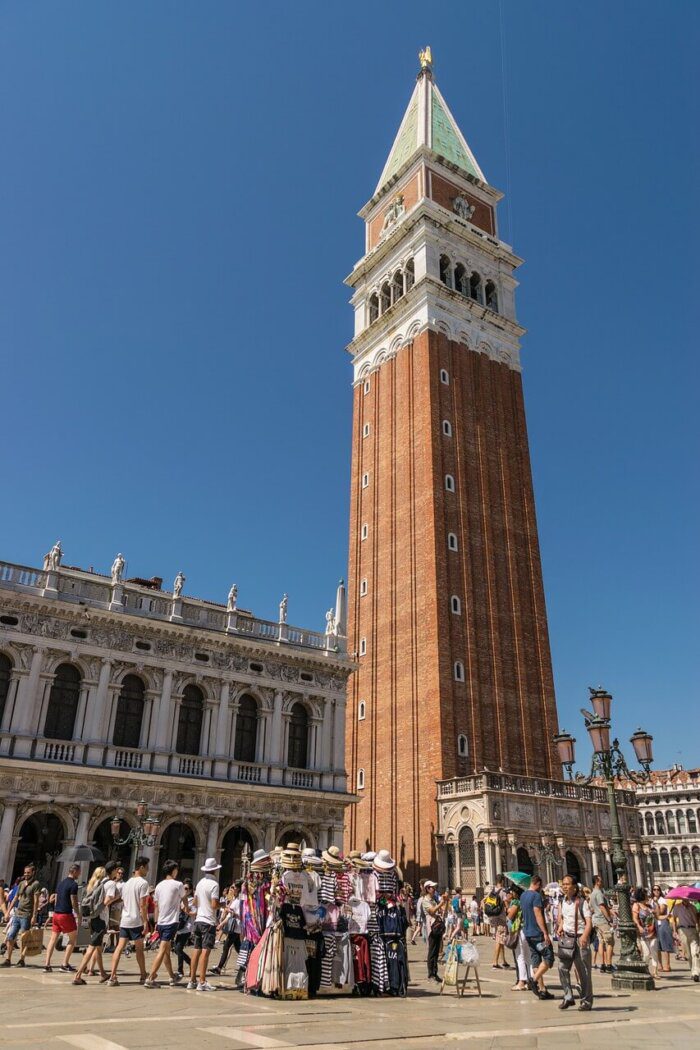
What is St. Mark’s Square and why see it?
St. Mark’s Square, the principal public square of Venice, is a breathtaking ensemble of architecture and history.
Known as “Piazza San Marco” in Italian, it’s flanked by the ornate St. Mark’s Basilica, the elegant Doge’s Palace, and the towering Campanile.
The square has been the social, religious, and political heart of Venice for centuries.
St. Mark’s Basilica, with its Byzantine domes and opulent mosaics, is a testament to Venice’s former power.
The adjoining Doge’s Palace, once the seat of Venetian government, showcases Gothic architecture at its finest.
The Campanile offers panoramic views of the city and lagoon. The square is also home to historic cafes and the famous Clock Tower.
St. Mark’s Square is special for its artistic and historical significance, serving as a grand symbol of Venice’s rich past.
Its combination of majestic buildings, cultural legacy, and lively atmosphere makes it a must-visit for anyone exploring Venice.
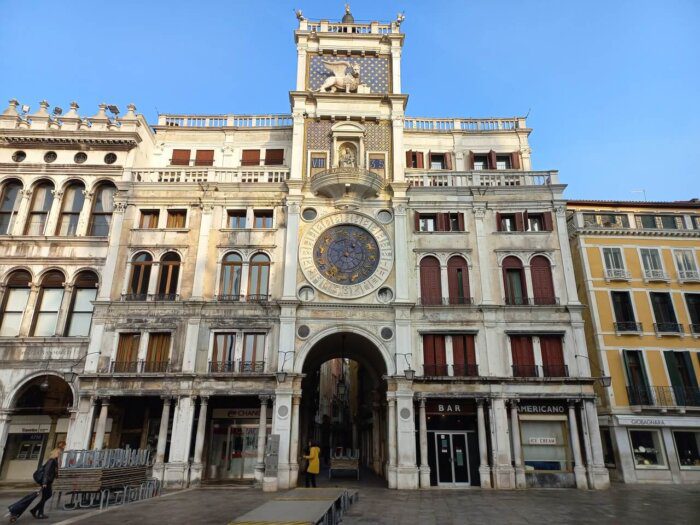
How to enjoy St. Mark’s Square?
St. Mark’s Square is centrally located in Venice, easily accessible on foot from most parts of the city. The nearest Vaporetto stops are “San Marco Vallaresso” and “San Marco Giardinetti” on Line 1.
Tourists should be aware of the high water, or “acqua alta,” which can flood the square during certain times of the year; raised walkways are provided during these periods.
Be mindful of the local regulations, such as not feeding the pigeons or sitting on steps and monuments.
Carrying a camera is a must, as the square offers some of the most iconic views of Venice.
Remember to respect the historical significance of the area and enjoy the unique atmosphere that St. Mark’s Square offers.
St. Mark’s Basilica (Basilica di San Marco)
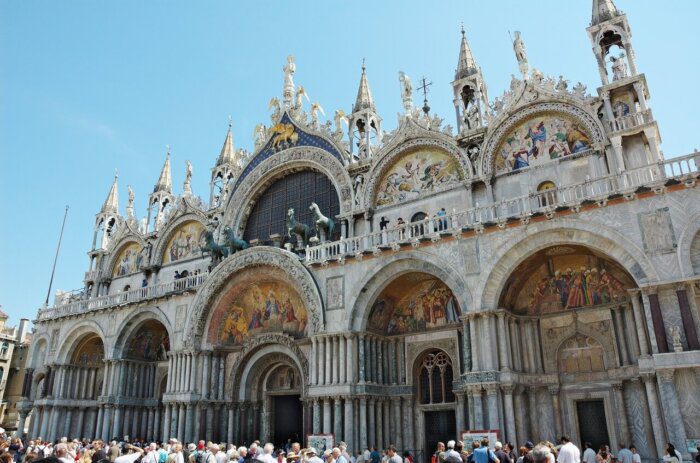
Did you know…?
St. Mark’s Basilica, known for its splendid Byzantine mosaics, conceals a fascinating, lesser-known historical treasure: the Tetrarch statue.
This ancient statue, located near the basilica’s entrance, is a significant relic of the Roman Empire. It was looted from Constantinople during the Fourth Crusade in 1204, a symbol of Venice’s power and influence.
The Tetrarch statue, depicting four Roman rulers, is unique due to its rare portrayal style and the material used – porphyry, a deep purple stone reserved for imperial use in Rome.
This piece of Roman history in the heart of Venice is often overlooked by tourists, but it represents a complex chapter of the city’s past, where art and politics intertwine.
Discovering this hidden artifact at St. Mark’s Basilica not only enhances the historical richness of the visit but also connects the dots between the ancient Roman Empire and Venetian history.
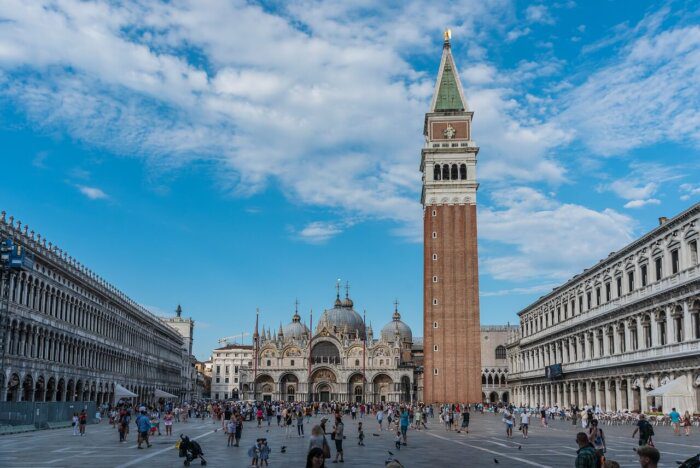
What is St. Mark’s Basilica and why see it?
St. Mark’s Basilica, a Byzantine architectural marvel, reigns over Venice’s St. Mark’s Square with its opulent design and gilded mosaics.
This cathedral’s façade, a blend of marble and gold, reflects the Venetian Republic’s former glory.
Adjacent to the basilica stands the Campanile di San Marco, a towering bell tower offering panoramic views of Venice. Inside the basilica, art abounds, with the Pala d’Oro, an altarpiece bedecked in jewels, and domes lined with mosaics depicting sacred scenes.
These artworks bathe the interior in a celestial glow. The basilica symbolizes both Venice’s spiritual heart and its maritime power, housing relics like St. Mark’s remains.
A visit to St. Mark’s Basilica and the adjacent Campanile di San Marco is a journey through Venice’s rich history, artistry, and religious significance, encapsulating the city’s golden age.
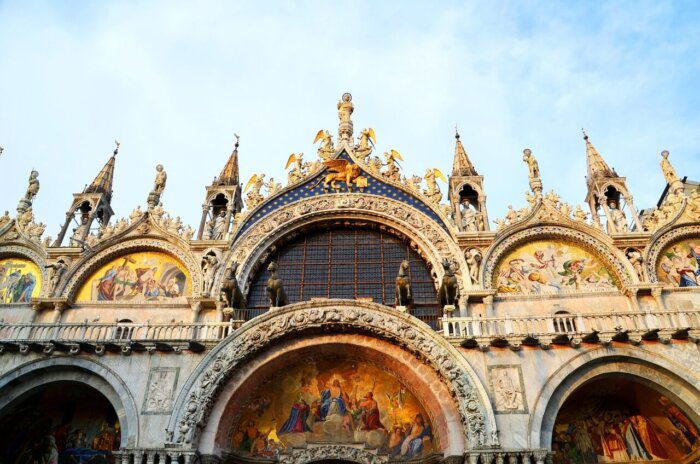
How to enjoy St. Mark’s Basilica?
St. Mark’s Basilica is located in St. Mark’s Square, at the heart of Venice. The easiest way to get there is by Vaporetto, with the closest stops being “San Marco Vallaresso” and “San Marco Giardinetti” on Line 1.
For tourists planning a visit, it’s important to note that the basilica often has long queues, so arriving early or booking a skip-the-line tour can save time.
Modest attire is required to enter the basilica, so visitors should ensure shoulders and knees are covered.
Photography inside the basilica is not allowed, allowing for a more immersive and respectful experience. The intricacies of the mosaics and architecture are best appreciated in silence and contemplation.
Additionally, be prepared for occasional closures due to religious services or maintenance.
A visit to St. Mark’s Basilica is not just a touristic activity but an opportunity to experience a piece of Venice’s rich history and spiritual heritage.
Conclusion
As we draw our journey through Venice to a close, we are reminded of the city’s captivating blend of history, art, and unique charm.
From the serene waterways of the Grand Canal to the ethereal beauty of St. Mark’s Basilica and its towering Campanile, Venice is a living tapestry of history and culture.
The narrow, mysterious alleys of San Polo, the bustling vibrancy of Rialto Bridge, and the artistic allure of Dorsoduro have all painted a picture of a city that is not just a destination, but an experience.
The hidden secrets of the Arsenale and the culinary delights originating in the quiet corners of Cannaregio add layers of intrigue and flavor to our exploration.
Each step through this enchanting city reveals a new chapter of a story that is waiting to be discovered.
Venice is not just a place to visit; it’s a world to be experienced, a treasure trove of wonders that beckons travelers to immerse themselves in its timeless magic.
So, pack your bags, wear your most comfortable shoes, and set forth on an adventure that promises to leave you with memories as splendid and enduring as the city itself.
Venice awaits, not just to be seen, but to be lived and cherished.
Happy travel
Marcin
My top places to see in Venice
- Arsenale di Venezia
- Cannaregio
- Doge’s Palace (Palazzo Ducale)
- Dorsoduro
- Grand Canal (Canal Grande)
- Punta della Dogana
- Rialto Bridge (Ponte di Rialto)
- San Polo
- St. Mark’s Square (Piazza San Marco)
- St. Mark’s Basilica (Basilica di San Marco)
Useful links
Venice public transportation website
Looking for more inspiration for places to visit?
The Best Of Europe: Top 10 Iconic Cities To Visit?
The Best Of North America: Your Ultimate Guide To 10 Most Vibrant Cities?

